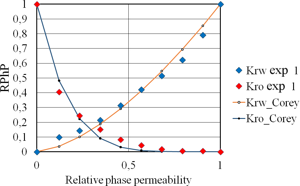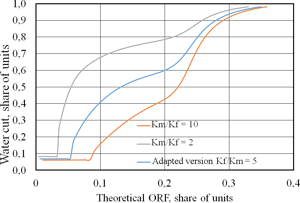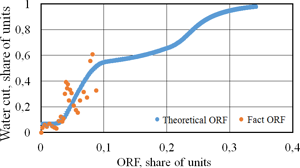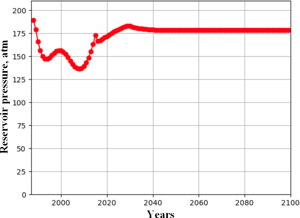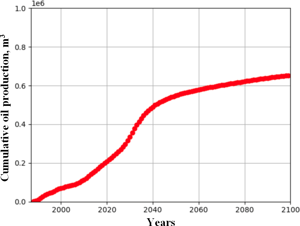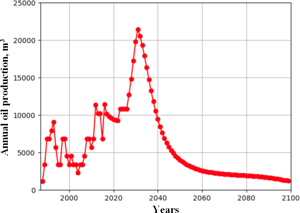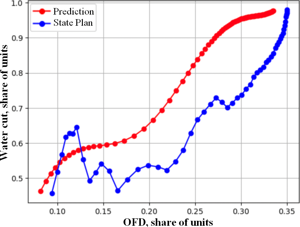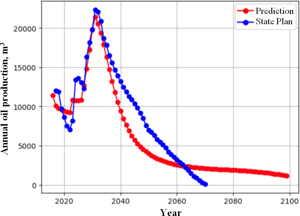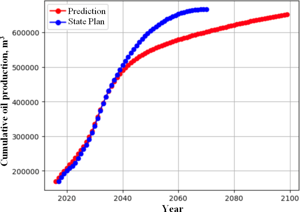Fetisov A.E., Anokhina S.Z.
The analysis of the development indicators of the Tournaisian deposit. Multiphase Systems. 20 (2025) 1. 26–32.
The analysis of the development indicators of the Tournaisian deposit
A.E. Fetisov
🖂, S.Z. Anokhina
Ufa State Petroleum Technological University, Ufa, Russia
Abstract
The purpose of the present investigation is to analyze the development indicators of the Tournaisian reservoir of the Ural-Volga oil field. To
complete this task, a large array of data is required, which has been obtained from the Technological Development Project. Numerical
calculation is performed using software code implemented in the Python programming language with the material balance method. To
minimize the material balance error in the software code, the optimize.minimize function of the SciPy library has been applied with the help
of the L-BFGS-B method. The analysis of current development indicators has shown uneven development of the reserves of the Tournaisian oil
deposit, as well as a positive effect of injection on the process of fluid displacement from the formation. In this paper, a material balance model
has been constructed and adapted to the forecast date. As a result, the average error in the adapted parameters is 3,7%. To make a forecast
for the development of the Tournaisian oil deposit, a dependence of the water cut of well production on the oil recovery factor based on core
material has been constructed. The graphs of the arithmetic mean and maximum values of the absolute deviation module of the calculated
water cut from the actual one, obtained due to a retrospective forecast of the synthesized from the Technological Development Project data
of hydrocarbon fields at different stages of development are shown. It has been found that water cut of 98% achieved at a oil recovery
factor equals to 0,335. The dependence of the reservoir flooding dynamics on the oil recovery factor has made it possible to forecast the
technological development indicators, including the calculation of the dynamics of annual and cumulative oil production, as well as reservoir
pressure. As a result of the calculation, the accumulated oil production has amounted to 649 thousand cubic meters with a water cut of 98%.
Keywordsthe Tournaisian reservoir,
development indicators,
the material balance method,
water cut forecast,
oil recovery factor,
relative phase
permeability,
numerical study
References
- Géron Au. Hands-On Machine Learning with Scikit-Learn and TensorFlow. O’Reilly Media, Inc., 2017. 572 p.
- Fetisov A.E., Khatmullina R.S. Research of numerical indicators for the development of the Asselskaya area of Orenburg oil and gas condensate field
using the material balance method. Multiphase Systems. 19 (2024) 1. 1–6.
DOI: 10.21662/mfs2024.1.001
- Kharisov M.N., Karpov A.A., Petrov S.V., Darii S.D. [Algorithm for the Determination of Displacement Characteristics] Algoritm opredeleniya
optimal’nykh kharakteristik vytesneniya. Neftyanoe khozyaistvo — Oil Industry. 2018. No. 5. Pp. 56–59 (in Russian).
EDN: XNSWVV
- Garifullin A.Sh., Kurmakaeva S.A., Rodin V.I. The Use of Empirical Dependences in the Design of the Krasnokholm Group Field Development. Collection
of Scientific Papers: Problems of Geology and Development of Oil Fields in Areas with Dwindling Resources. Ufa, BashNIPIneft’ Publ. 1989. Pp. 81–86
(in Russian).
- Schilthuis R.J. Active Oil and Reservoir Energy. Transactions of the AIME. 118 (1936) 01. 33–52.
DOI: 10.2118/936033-G
- Zakirov R.Kh. Role of geological-hydrodynamic modelling at designing of oil field development // Georesources. 32 (2009) 4. Pp. 34–36 (in Russian).
EDN: kxykgl
- Muskat M. The Flow of Homogeneous Fluids through Porous Media. McGraw-Hill Book Company, 1937. 763 p.
- Peaceman D.W. Fundamentals of Reservoir Engineering. Elsevier Scientific Publishing Company, 1977. 176 p.
- Mohaghegh S. Data-Driven Reservoir Modeling: A New Paradigm in Reservoir Management. Society of Petroleum Engineers, 1945. 166 p.
- Arps J.J. Analysis of Decline Curves. Transactions of the AIME. 160 (1945) 01. Pp. 228–247.
DOI: 10.2118/945228-G
- Technological project for the development of ONGCM. LLC VolgoUralNIPIgaz, 2012 (in Russian).
- Lutz M. Learning Python, 4th edition. O’Reilly Media, Inc., 2009. 1213 p.
- Nocedal J., Wright St.J. Numerical Optimization, 2nd edition. USA: Springer, 2006. 684 p.
- Fanci J.R., Christiansen R.L. Introduction to oil production technology. Hoboken, NJ: John Wiley & Sons, 2009. 290 p.
- Mishchenko I.T. Calculations in oil and gas production. Moscow: Neft’ i gaz. 2008. 296 p. (in Russian).
- Corey A.T. The Interrelation between Gas and Oil Relative Permeability. Producers Monthly. 19 (1954) 1. 38–41.
- Gu Sh., Liu Yu., Chen Zh., Ma C. A method for evaluation of water flooding performance in fractured reservoirs. Journal of Petroleum Science and
Engineering. 120 (2014). 130–140.
DOI: 10.1016/j.petrol.2014.06.002
- Dake L.P. Fundamentals of reservoir engineering. Amsterdam: Elsevier, 2003. 496 p.



